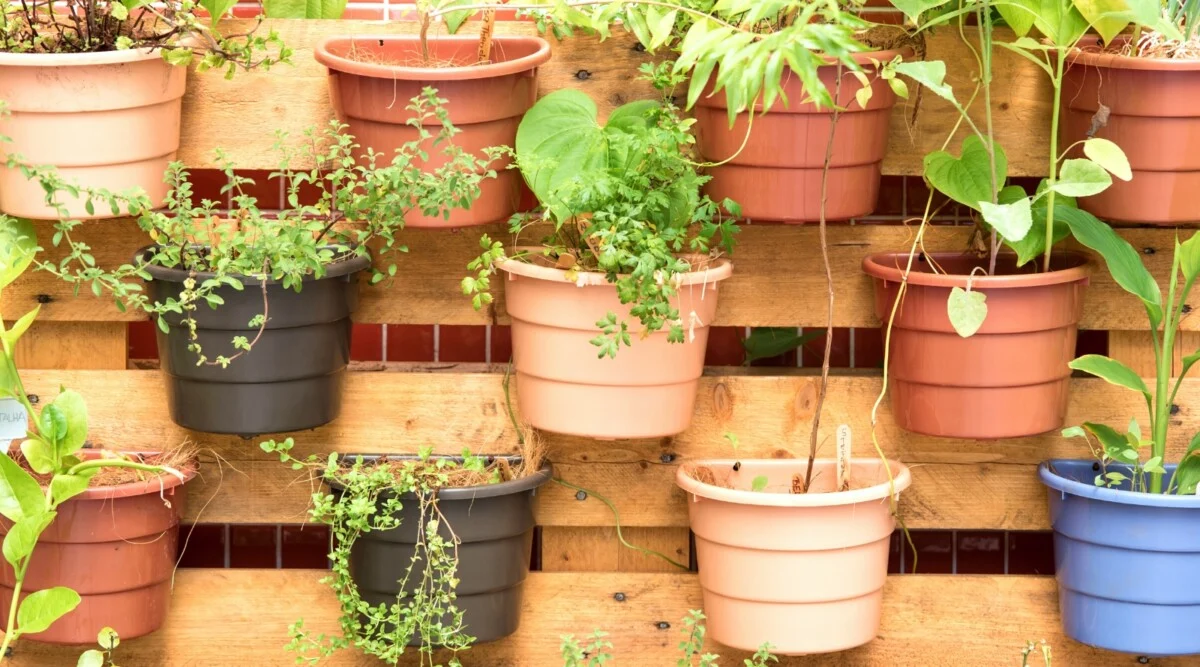Maximizing Small Spaces With Vertical Gardening

If your garden space is limited, going vertical may allow you to increase food production in less area. Learn how to build trellises and tunnels for growing vegetables such as green beans, tomatoes and cucumbers.
Most vineing, climbing and clinging plants will attach themselves easily to trellises; however, some might require additional work like tying or twining.
Hanging Baskets
Installing hanging baskets or creating a green wall of cascading wave petunias adds beauty and dimension to any garden. Use creative containers like mason jars, old dressers or even pallets repurposed from other projects as ways to extend creativity into your gardening. The possibilities for creativity are limitless!
Vegetables like cucumbers and tomatoes can be grown vertically by adding trellises to your landscape. Vining crops typically climb naturally up wooden, plastic or wire fences using stakes, clips and teepee-style trellises for support.
Heightening planters is one way to combat weed growth by keeping plants out of sight. Make sure to choose lightweight materials so they are easily moved around for maximum sunlight exposure, such as lightweight soil rich with nutrients for your plants that is well-suited to container gardening.
Trellises
Trellises offer an effective solution for growing vegetables, herbs, or flowers without taking up precious floor space. A simple trellis panel secured to a wall can serve as support for potted herbs and flowers as well as provide space to grow cucumbers, squash tomatoes or pole beans.
Plants that twist, twine, climb or cling easily make excellent trellis plants. Try Boston Ivy (Parthenocissus tricuspidata) as a non-invasive option or consider more exotic vining species such as Hyacinth Bean Vines (Lablab purpurea) and Passionflowers (Passiflora incarnata).
No matter which vertical gardening method you select, watering must be done frequently to maintain healthy plants that don’t exist in the ground. Wands, timers or drip irrigation systems can be useful tools in keeping these gardens hydrated; regular pruning also keeps plants healthy while preventing overcrowding. Placing a tray beneath indoor or outdoor planters to catch any drainage water may prevent potential damage to floors or walls from any excess drainage water runoff.
Wall Planters
Planters are an easy way to add color and texture to any indoor or outdoor space. You can craft your own from recycled items, like mason jars or tin pails, or buy premade ones ready to grow. Opt for lightweight materials that can easily be moved around for optimal sun exposure; avoid planting too close together so you can reach and maintain them easily.
Vertical gardening can save time and effort when growing vegetables or ornamental flowers, eliminating the need to squat down or kneel. Off-ground plants also are less likely to be invaded by common garden pests.
Vegetables like peas, pole beans, and indeterminate tomatoes make an ideal pairing on trellises; leafy greens and herbs with shallow root systems work better in containers. Be mindful that wall-mounted planters may require more frequent watering; use micro or drip irrigation systems to conserve water without overwatering.
Tumbling
Plants that twine, climb or cling naturally add dimension to any garden. You can train these vines to climb trellises, fences or freestanding structures such as pergolas or arbors.
Vertical farming exposes your crops to more sunlight, which is crucial in producing high yields. Furthermore, harvesting vertically makes for simpler fruit collection while decreasing time spent lying on the ground where they could be exposed to rot or damage.
DIY vertical gardens can be created easily using items already on hand, such as Mason jars, old dressers, windowsill planters or wooden crates. Mason jars, old dressers, windowsill planters and wooden crates make great containers for planting herbs or vegetables in wall planters indoors; heavy varieties may cause indoor wall planters to topple over and so light varieties should be selected or make sure your trellis panel is securely fastened to the wall for best results. It may be wise to familiarize neighbors or friends with your vertical garden should an emergency arises so they can help tending the crops when necessary.







